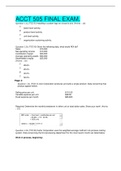Essay
Unit 4 Aim D: Storing and Communicating Scientific Information / LIMS (DISTINCTION)
- Course
- Institution
This is my distinction grade assignment for unit 4 aim D on storing and communicating scientific information / laboratory information management systems (LIMS). All criteria were met and I was awarded distinction. If you have any questions or concerns, please do not hesitate to get in touch. ...
[Show more]




